
MSGA ANNUAL MEETING NOTICE
MSGA’s Delegate Session & Annual Meeting
When: Tuesday, Jan. 20, 2026, at 9 a.m.
Where: Mayo Clinic Health System Event
Center in Mankato during MN AG EXPO
All active MSGA members are invited to attend.


MSGA ANNUAL MEETING NOTICE
MSGA’s Delegate Session & Annual Meeting
When: Tuesday, Jan. 20, 2026, at 9 a.m.
Where: Mayo Clinic Health System Event
Center in Mankato during MN AG EXPO
All active MSGA members are invited to attend.
If you’re like me, you’ve surely read an endless number of articles and headlines this year emphasizing the challenges that farmers, especially soybean producers, are currently facing regarding trade and tariffs. Heck, you’ve probably come across my name or those of my MSGA colleagues in those very news pieces! But rather than dwelling on the negatives too much, I want to point out that if you zoom out and look at the big picture, there are many aspects of our industry to remain positive about.
For starters, we had a pretty good growing season in Minnesota. Expectations heading into the fall harvest were pretty high. Overall, on our farm, we had an average-to-slightly-aboveaverage soybean crop. I would venture to say a lot of growers across the state would say the same. Mother Nature treated us fairly, and I feel lucky to be able to harvest the crop we did.
Another positive to focus on is biodiesel, which has come a long way over the past 20 years in creating domestic demand for our soybeans. I was still pretty wet behind the ears when the team at MSGA put in the legwork for the nation’s first-ever B2 mandate in 2005 – which is an incredible feat and team effort – and look how far we’ve come since then. We went from B2 blends to B5, B10 and now B20. Through doing so, we’ve increased the demand for our soybeans by double digits, created thousands of jobs, boosted the economy by billions – and we’re ahead of the curve in seeing the need to reduce emissions.
What really excites me is what’s ahead for the biofuels industry. As a nation, we continue to steadily increase production, which during times like these can act as a kickstand to hold us up until our markets return. We use biodiesel on our farms and on the roads, but looking to 2026 and beyond, there
is a great opportunity for biodiesel to make its way into the marine shipping industry. From a demand perspective, utilizing biodiesel in the marine industry, which consumes between 70-80 billion gallons of fuel per year worldwide, would be a game changer. Just imagine: Our soybeans being transported across the ocean in a vessel being powered by the very soybeans it’s transporting. How cool would that be?
Wow, I’ve written almost 400 words without addressing the elephant in the room: tariffs. I know a lot of farmers ran out of patience this fall, as the administration worked to secure lasting trade deals. I’ve maintained over the course of this year that the administration is working in good faith to get deals done that will be better in the long term for U.S. farms, and just as this issue went to press, we learned that China, our largest customer, is resuming purchases of U.S. soybeans. I know practicing patience hasn’t been easy, because we’ve been stuck in – as MSGA member Matt Schreurs put it – “a perfect storm of ugly” of high inputs and low prices. We’re pleased the administration heeded our warnings and placed soybeans as a top priority during these trade negotiations. As the dust settles on agreements with China and other trading partners, rest assured your nonpartisan MSGA membership dollars are hard at work exploring all avenues to protect our soybean farmers and keep our family farms on the land for generations to come.
Lastly, as we finish up our fall fieldwork and dust off our combines – I just want to thank you for supporting MSGA and I hope you and your farm had a safe and happy harvest!
Darin Johnson President, Minnesota Soybean Growers Association
MSGA discusses concerns, domestic opportunities with Gov. Walz, MDA
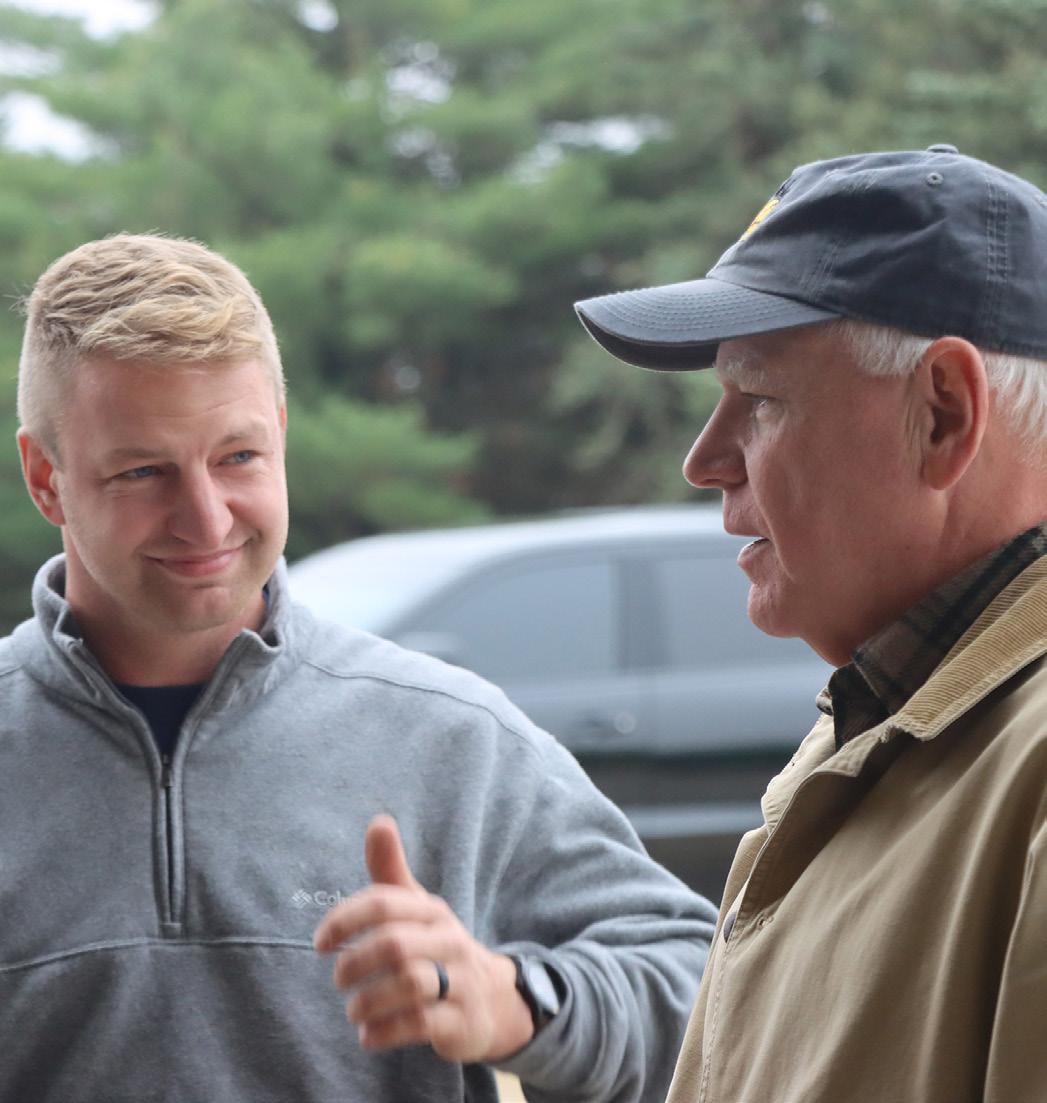
By Drew Lyon
Matt Purfeerst has traveled a long way – figuratively, if not literally – since a stint a dozen years ago interning as an ambassador with Minnesota Soybean. Yet, through local advocacy, hosting trade teams and several rounds of media interviews, the Faribault farmer, husband and father of two children continues serving as an ambassador for the organization.
“I guess I never really graduated from the program,” Purfeerst said with a chuckle. “It all comes down to promoting our industry and our farmers.”
Purfeerst, the Rice County director with the Minnesota Soybean Growers Association (MSGA) since 2023, was a stalwart advocate for his industry colleagues during the 2025 harvest. In a matter of weeks, he and his dad, Jim, hosted a Korean trade team; talked farm policy with Sen. Amy Klobuchar and visited with CBS News and the Guardian on his farm. On Oct. 15, during a hard-earned respite from harvest after receiving nearly an inch of rain the day prior, the Purfeerst family welcomed Gov. Tim Walz and the Minnesota Department of Agriculture to their family farm to discuss ongoing challenges and future openings within the farm economy. MSGA Executive Director Joe Smentek also attended to discuss how state-level policies can play a role in improving a stagnant farm economy.
“Our farmers are truly leading the way in highlighting the federal and state issues that are limiting their ability to thrive,” Smentek
said. “We all wish we were sharing better news, but MSGA’s message is being delivered from here at home to media literally across the world: Washington, D.C., Europe, Asia, Australia and markets in between. MSGA is looked upon as a dependable source on what’s currently happening in the farm economy, and that reputation is well deserved.”
Since 1962, MSGA has put policies above partisan politics, working with both parties to fight for farmers to develop markets, ease regulatory and tax burdens and promote new uses. Any legislator, no matter their political affiliations, who is interested in learning more about agriculture is treated like a welcome guest on the Purfeersts’ farm.
“We’re having an open discussion on what solutions might be out there and what we’re seeing,” Matt Purfeerst said. “Anytime we get a chance to promote agriculture, we’re going to invite anybody down, no matter what (policitical) side you lie on. It takes a whole team effort.”
During an hour visit to the Purfeests’ sixth-generation grain and cattle operation, which has produced a crop every year since 1857 – “This farm’s been here since before Minnesota (was a state),” Gov. Walz pointed out – the governor visited with Matt, Jim and Matt’s brother, Mark, and assorted family members to learn more how tariffs, low commodity prices and stubbornly high input costs and interests rates are creating a crisis in farm country, not to mention health care prices for farm families.
“We’ve seen a 40% drop in commodity prices since 2022 without our input costs going down,” Jim Purfeerst, a Rice County commissioner, told Gov. Walz. “We’re getting crunched from both sides.”
Gov. Walz also added that calls seeking financial and mental health assistance through MDA’s Minnesota Farm & Rural Helpline (Phone: 833-600-2670; Text: FARMSTRESS to 898211; or Email: farmstress@state.mn.us) are the highest on record.
“These folks are in a tough time,” he said.
Tariffs are adding fuel to the economic calamity for many farmers. Minnesota was the nation’s fourth-largest soybean producer in 2024 – the state’s over 25,000 producers harvested nearly 330 million bushels last year – and depends on exports to boost profitability. The current trade uncertainty with China caused a drop in exports; typically, one in four rows of Minnesota soybeans is sent to China. In total, Minnesota soy farmers export over $2 billion each year, accounting for about 25% of all the state’s ag exports.
“Politicians didn’t create these markets; producers did,” said Walz, citing the U.S. soybean industry’s four-decade long investment in growing markets in China.
At the start of the 2025/26 marketing year, China had yet to make a single purchase of U.S. soybeans, and the state’s overall exports had dipped by nearly 20%.
A couple weeks after the governor’s visit to Faribault, growers applauded a trade truce between the U.S. and China.
Continued on page 8
“This is an important industry for all of us. It’s a core of who we are as Americans and as Minnesotans. We need to find some solutions,” Gov. Walz said. “We’re producing a lot of beans – we’ve just got to get them to where they need to go.”
The governor and the Purfeersts also discussed the necessity of federal assistance once the government shutdown ends and urged federal lawmakers to work together to pass a relief package, along with a “skinny Farm Bill.”
“Our farmers will tell you they don’t want it, but I’m supportive. They need to get the resources now,” Walz said. “This is not the solution, it is a Band-Aid, but when you need a Band-Aid, use the Band-Aid.”
The governor and Minnesota Soybean agreed that there are myriad opportunities here at home and internationally to diversify demand. Walz said his administration is dedicated to working with lawmakers and private industry to position Minnesota as a leader in the sustainable aviation fuel (SAF) and biofuels marketplaces.
“I’m 100 percent behind pushing SAF as hard as I can,” he said.
MSGA and its partners at the Minnesota Soybean Research & Promotion Council continue to promote and educate on the over 1,000 commercially available soybased products, including sneakers, firefighting foam, road sealants, paints and roof rejuvenators.
“Joe (Smentek) has been wanting me to buy soy tires,” said Gov. Walz, who indeed has a set of Goodyear’s soybased tires on one of his official vehicles.
Smentek said that while federal policies are influencing farmers’ bottom lines, the Minnesota Legislature and Walz administration can also play a more active role in the upcoming legislative session toward improving the outlook for Minnesota agriculture, the state’s secondlargest industry, by supporting animal agriculture producers and easing truck-weight restrictions.
“We could talk for hours and hours about the issues affecting farmers,” he said. “Every administration, we have challenges. … There’s always something to work on, that’s why we’re a nonpartisan organization. We appreciate the spotlight these issues are getting.”
Minnesota Soybean is focused on promoting growing new markets in the months and year ahead while urging a longterm trade solution with Chinese trade partners. Smentek recently visited Taiwan and will join MSGA President Darin Johnson and the Walz administration in November on a trade mission to Europe, which is the second-largest market for U.S. whole soybeans and soybean meal.
“We have a better product than South American soybeans,” Smentek said. “There’s a desire to get back to normal on both sides. … We still are holding out hope. Other markets, we continue to work on. We need everything.”
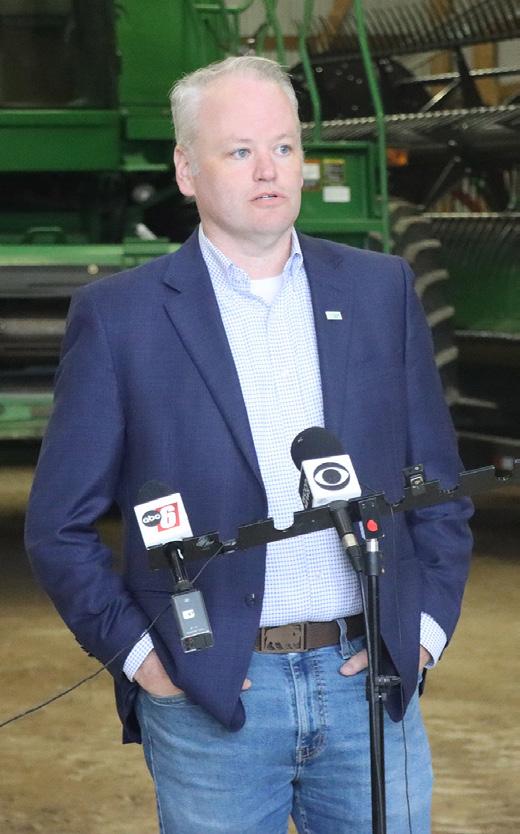
Executive Director Joe Smentek discusses trade and domestic market opportunities during a press event
In the weeks leading up to, and through, harvest, MSGA remained engaged with a bipartisan group of legislative leaders, trade team partners and media at the state, national and international levels. MSGA’s officer team appeared in the Washington Post, Star Tribune, Chicago Tribune, the BBC and more. All told, MSGA earned hundreds of millions of media impressions over the course of just a few months.
Along with the Purfeersts’ meeting with Gov. Walz, Director Joel Schreurs hosted Amy Klobuchar in September, while President Darin Johnson and Vice President Ryan Mackenthun met with Rep. Brad Finstad.
“I think everyone is hoping the news cycle dies down a little bit,” Darin Johnson said. “That said, it’s been truly inspiring to watch our directors step up and be willing to participate in so many media interviews, even with outlets that might not normally reach out to us.”


















By Deanna Kanne



























































The long-anticipated Public Waters Inventory (PWI) undertaken by the Minnesota DNR continues to take shape heading into 2026.
As part of the 2024 legislative session, the Minnesota DNR announced its plan to update the PWI. It will be an eight-year effort, with the goal to review 12 counties each year. First up (in semialphabetical order) are Aitkin, Benton, Blue Earth and Clay counties.
The Minnesota Soybean Growers Association (MSGA) has raised its concerns with the legislation since it was proposed, warning of unintended consequences. Currently, farmers are about 99% compliant with the buffer law, and this legislation still won’t provide regulatory certainty.
“We could have found a way to update the maps, let farmers, let landowners have a voice in that process, but then make sure that the maps were the law,” said MSGA Executive Director Joe Smentek. “Right now, at the end of this process, we’re going to have 8 million dollars worth of updated maps and it’s still not going to give us regulatory certainty. … It could cost farmers a lot of money to litigate.”
For each county, in general, the DNR will update the PWI in the following steps:
• Send an initial notice to the county, soil and water conservation district, and watershed agencies.


• Prepare a preliminary map reflecting the corrections and any modifications and submit it to the county board with a public meeting date. Potentially affected landowners will receive direct mail notice.
• Host a public meeting, in conjunction with a county board meeting, to elicit public feedback




















on the preliminary revisions to the map. The comment period on the corrections and modifications made in the preliminary map opens 30 days before the public meeting date and closes 30 days after the public meeting.
• Provide 90 days for parties (including riparian landowners) or counties wishing to challenge a decision made by the DNR to request Commissioner review of the modified and updated PWI.



• Review the feedback received during the comment period and make necessary modifications to the preliminary map. This revised map, now a provisional final map, will be submitted to the county and made available on the DNR’s project web page.
• Issue the updated PWI list and map for the county, upon completion of DNR Commissioner review.
Growers are encouraged to visit the DNR’s website to sign up for PWI updates.
“We’re going to continue to keep a close eye on these updates and how they could affect our producers,” MSGA President Darin Johnson said.
While MSGA is focused on advocacy, the Minnesota Soybean Research & Promotion Council is tasked with sponsoring soy checkoff initiatives that take a closer look at issues facing Minnesota farmers. At the Council’s August 2025 meeting, grower leaders approved a project with Houston Engineering, Inc., to identify how the statutory definition of public waters could impact the total miles of regulated waters across Minnesota on new LiDAR. Results of this study are expected to be made available later in 2026.
By Deanna Kanne and Drew Lyon
Twenty years is a long time. Two decades ago, in 2005, George W. Bush was president, “The Office” premiered on network TV, Hurricane Katrina hit Louisiana, Zygi Wilf took ownership of the Minnesota Vikings and soybeans averaged under $6 per bushel.
To ignite the soybean economy, Minnesota lawmakers passed a biodiesel law that had wide-ranging ramifications in the state’s economy and environment. Across two decades, the benefits of the legislation far exceeded the wildest dreams of even its strongest proponents.
Time, well, it’s all relative – for some, it’s a lifetime, for others, 20 years of Minnesota’s historic adoption of biodiesel went by in a blink of an eye.
“It’s hard to believe it’s been 20 years already,” said Lincoln County farmer Bob Worth, who served as Minnesota Soybean Growers Association (MSGA) president in 2005. “In some ways, it feels like yesterday.”
In 2002, with leadership from MSGA and support from the Minnesota Soybean Research & Promotion Council (MSR&PC), the historic biodiesel law was passed in the Minnesota Legislature. Minnesota’s biodiesel processors were required to produce 8 million gallons of B100 in production sites
before MDA gave final approval. Three biodiesel plants were built in Minnesota between 2002-2004, more than enough to meet the production requirements. The law officially took effect three years after the legislation on Sept. 29, 2005, when B2 pumps were implemented around the state. Minnesota was the first state to require a biodiesel percentage in their diesel fuel.
Alongside Worth and Minnesota Soybean, former Gov. Tim Pawlenty and former Minnesota Department of Agriculture Commissioner Gene Hugoson were key in starting a biodiesel industry, practically from scratch.
“It was certainly a team effort in getting the law into place and implemented,” Hugoson said in September 2025. “There were other attempts to try to find value-added to soybeans but there’s no doubt that the biodiesel was the success that had long-term sustainability. Biodiesel was a process of bigger usage of soybean oil, so that made a big difference.”
The movement started as a grassroots collaboration between farmer leaders from both MSGA and MSR&PC. The Council helped fund research showing the benefits of biodiesel, while MSGA tackled the policy side
of engaging with legislators and industry leaders.
‘Clear vision’
Since the 2002 mandate passed, Minnesota has been steadily increasing the requirements. The most recent increase was passed in 2018, bringing requirements up to B20 for the summer months, another first for the nation.
When the blend requirements change, the production changes as well. In 2005, Minnesota production was 16 million gallons per year. In 2022, that had increased to 74.6 million gallons per year.
“It’s farmer grown,” Worth said. “That’s something that really impressed me – that we can grow our own diesel fuel. It takes a million years to create a gallon of fossil fuel, but it only takes nine months for a gallon of biodiesel.”
Minnesota produces about 74 million gallons of biodiesel and consumed 77 million gallons – 96% of the biodiesel consumed came straight from Minnesota farms.
Since the B20 mandate went into effect in 2018, there has been a lot more biodiesel used around the state, and 2022 numbers show Minnesota farmers produced 60% of what was consumed.
“Being able to source your product close to home certainly makes a lot of sense,” said Hugoson, who still farms in Martin County. “Minnesota Soybean had a clear vision.”
Biodiesel has helped increase the value of soybeans in Minnesota and around the country. Biodiesel adds value to soybeans by about $1 per bushel and boosts demand by 13%. In Minnesota alone, biodiesel is adding nearly 5,400 jobs and contributing nearly $1.7 billion toward our state’s economy, totaling $676 million in farm-level impact statewide.
“All the economic indicators show that biodiesel is improving farmer profitability and building demand for soybeans grown right here in Minnesota,” MSGA President Darin Johnson said.
Aside from economic benefits, the biodiesel industry is protecting the environment. Studies show that biodiesel reduces greenhouse gas emissions by more than 50% and displaces roughly 130 million gallons of petroleum diesel in Minnesota each year. Using a B20 blend in the summer and a B5 blend in the winter
equates to removing the emissions from nearly a quarter-million vehicles from state roads every year.
After Minnesota opened the door, many other states implemented biodiesel requirements. Washington was the second state to implement a mandate in 2006. Iowa state vehicles use B20 year-round and the city of Ames runs its snowplow fleet on B100. Texas is the No. 1 market for biodiesel and the No. 2 producer. Currently, 18 states have a biodiesel mandate.
“What Minnesota did has helped inspire other states to do similar
legislation,” said Tom Verry of Clean Fuels Alliance America. “We learned so much as an industry from Minnesota.”
Worth said Minnesota raised the standard, yet the work continues, both in Minnesota – where MSGA continues to promote higher blends of biodiesel, along with promoting soybean oil as a feedstock in sustainable aviation fuel – and across the U.S.
“I hope we can get it nationwide,” Worth said. “We have to get the rest of the states on board. I’m very proud of Minnesota Soybean for pushing this.”

Then MSGA President Bob Worth (front) speaks alongside Gov. Tim Pawlenty during an event promoting Minnesota’s historic move to B2 on Sept. 29, 2005. This fall, Minnesota Soybean celebrates two decades of biodiesel leadership.

MEG CORP’S PARTNERSHIP WITH MN SOYBEAN
By Sydney Harris
It’s taken no shortage of blood, sweat and tears for Minnesota to become a biodiesel trailblazer. And since the beginning, MEG Corp has been right alongside Minnesota Soybean fighting the biodiesel fight.
Twenty years ago, as the first state to pass a biodiesel mandate, Minnesota officially implemented its B2 biodiesel blend requirement. On Sept. 29, 2025, Minnesota’s biodiesel industry celebrates two decades since B2 arrived at fuel pumps.
“It’s a huge achievement to look back on 20 years since the law went into effect,” said Bob Worth, who served as president of the Minnesota Soybean Growers Association in 2005.
But the road was anything but smooth, which is what spurred the Minnesota Soybean Research & Promotion Council (MSR&PC) to pick up the phone and call MEG Corp.
“Our partnership with MEG Corp started when we were getting ready to implement the two percent biodiesel effort,” said Mike Youngerberg, MSR&PC’s senior director of product development and commercialization. “We needed
somebody in state that had been around petroleum and doing analysis work to make sure that the biodiesel contents were right.”
An industry leader in product solutions, testing services and fuel consulting, MEG Corp provides critical expertise to fuel distributors, fleets, mechanics and others who utilize fuel in their operations.
Founder and president of MEG Corp, Hoon Ge is a chemical engineer with 35 years in the petroleum industry including refining, additive formulation and alternative fuels.
When the implementation of biodiesel developed a case of the hiccups, instead of holding its breath and hoping for the best, MSR&PC called Ge.
“Unfortunately, when the biodiesel mandate first went into effect, it didn’t go smoothly, so Mike reached out to see if we could help figure out what was going on,” said Lisa Pedderson, who has worked at MEG Corp since 2007. “Hoon had samples delivered to his garage and analyzed them all, eventually figuring out that there was off-spec biodiesel that hit the market and was plugging filters.”
Soon, a convoy was rocking through the night across Minnesota. Education and training were key.
“After that was determined, they developed a road show with various people and went around Minnesota talking to fuel suppliers and end users about what they found and what was being done to address the problem,” Pedderson said.
Since then, MEG Corp’s partnership with MSR&PC has evolved to encompass several initiatives that are funded with Minnesota soybean checkoff dollars, including diesel mechanic workshops and an annual See for Yourself trip to the Clean Fuels Conference.
“They’ve actually taken on more education efforts,” Youngerberg said. “They do training for students at technical colleges, teaching the mechanics up front about fuels. A lot of the technical colleges touch on everything about how to take the engine apart but only dedicate an hour talking about the fuel itself.”
The workshops are an integral part of MEG Corp’s efforts.
“We’re training a new generation
Continued on page 14

of mechanics to be open minded about biofuels,” Pedderson said. “The workshops have been very helpful to have this newer generation become familiar with and confident in biodiesel blends.”
Every winter, a delegation of Minnesota soybean farmers and fuel industry representatives make their way to the Clean Fuels Conference, hosted by Clean Fuels Alliance America. For Pedderson, it’s a highlight of the year.
“We’ve been working with Minnesota Soybean since 2012 to bring groups of fuel suppliers, fleet managers and others in the petroleum industry to the Clean Fuels Conference,” Pedderson said. “They’re able to see what’s going on with biodiesel and renewable diesel around the nation, not just in Minnesota. I think the programming has gone a long way to change attitudes and resulted in fuel industry and fleet staff in Minnesota seeing the benefits and opportunities of biodiesel.”
So, why did fuel education become so important? Biodiesel was becoming the scapegoat anytime an engine-related issue arose, even when it wasn’t deserved.
“For ages, nobody worried about diesel fuel,” Youngerberg said. “It was either number one or number two diesel and it lasted forever. And when, in 2007, they lowered the sulfur content to reduce pollution, that’s when the problems started. And about that same time is when the two percent biodiesel mandate started so we got blamed for multiple problems that weren’t ours.”
Just as MSR&PC’s checkoff investments and promotion of biodiesel didn’t come to a screeching halt when the biodiesel mandate went into effect, neither did the learning curves. Another wave of aches and pains hit when the blending requirements increased to B5 in the winter months and B20 in the summer.
“It was new for everybody,” Pedderson said. “Education was needed about recent changes in diesel fuel, biodiesel and how these two fuels work together. It was important to provide fuel education before the B10 and B20 mandates took effect.”
Without MSR&PC’s collaboration with MEG Corp, Minnesota’s biodiesel landscape would look drastically different. From the get-go, Minnesota has been a biodiesel trailblazer, setting the standard for biodiesel usage and MEG Corp has played a significant role in putting Minnesota at the top of the leaderboard.
“It would be a real challenge for Minnesota’s biodiesel industry to be where it is without MEG Corp from the sheer standpoint that we don’t have the bandwidth to do it ourselves, and we don’t have the connections which are very important when it comes to the fuel industry,” Youngerberg said. “It’s been an invaluable partnership.”

Hoon Ge is the founder of MEG Corp and a longtime supporter of Minnesota Soybean. MEG Corp is celebrating its 20th anniversary in 2025.
MEG Corp is also a sponsor of Minnesota Soybean fundraisers, including MN Ag Expo and MSGA’s 8x17V Mille Lacs Vacation Series Fish House. To purchase a ticket for the fish house raffle, call MSGA’s office at 507-388-1635. The winner will be drawn during MN Ag Expo on Jan. 21, 2026.




By Mark Askelson
With a goal of strengthening trade relations and expanding market opportunities, Minnesota Soybean Research & Promotion Council (MSR&PC) and Minnesota Soybean Growers Association (MSGA) staff leaders joined the USDA, along with other commodity organizations and agribusinesses, on a trade mission to Taiwan, one of U.S. agriculture’s largest export markets.
“The U.S. has had a longstanding relationship with Taiwan and they’ve been a really great trade partner with the U.S. when it comes to ag products, such as soybeans, corn, wheat and various fruits,” said MSGA Executive Director Joe Smentek, who participated in the Taiwanese trade visit that took place at the end of September 2025. “I think some people see it as
“We were able to network with other trade associations and businesses from across the country to discuss their challenges and opportunities, and we’re all trying to do the same thing – promote agriculture.” - ShaneFrederick
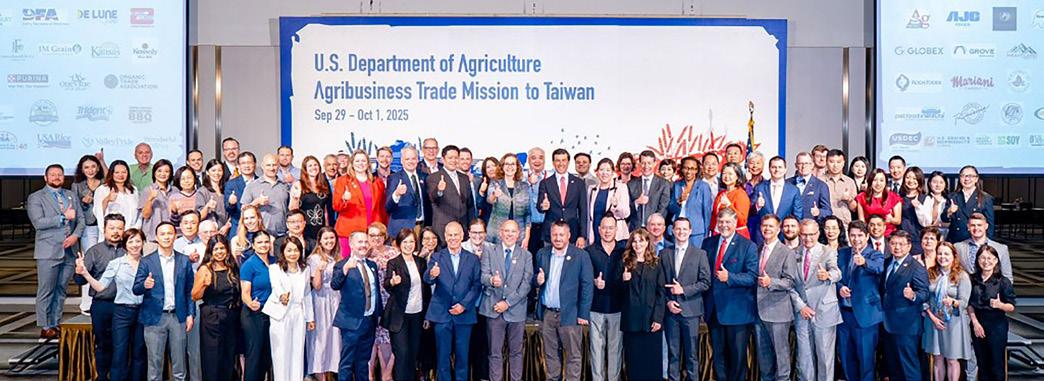

a mature market, but there’s a lot of growth opportunities there with even more soy and corn going into that country.”
According to USDA, Taiwan is the eighth largest market of U.S. agricultural exports, and those numbers are rising, with trade growing by 16% over the last five years. From a soybean perspective, Taiwan imports soy for both human and animal consumption, and there’s even greater interest in using soybean oil for biofuels. Smentek is optimistic and anticipates demand for U.S. soybeans could grow by more than 50-60% in the years ahead.
“We’re really trying to shrink that agricultural trade gap and move more soy over to Taiwan,” Smentek said.
As part of the itinerary, participants visited Taiwanese government officials, as well as companies that are importing U.S. soy. Smentek also obtained perspective into the daily lives and culture of the people on the island, which supports a population of nearly 25 million.
“It is a country that eats out a lot – not a lot of home-cooked meals because they have pretty small apartments – and convenience stores are actually a growing source of where they eat out at,” said Smentek. “So, along with the opportunity to import more soy, there is also the interest in importing more meat products to fit some of those needs.”
Joining Smentek on the trip from
Minnesota was Shane Frederick, manager of market development and promotion for MSR&PC and manager of strategic programs with Specialty Soya and Grains Alliance, who used the opportunity to promote the U.S. Identity Preserved (IP) brand program, which assures customers that the grains and oilseed products they’re purchasing are safe, secure, highquality and grown with a purpose.
“For those who weren’t familiar with identity preserved, it was an opportunity to promote what it is and the benefits, and for those who were familiar it was good to get feedback, how we can grow it and how we can reach their customers so that the label can get more recognition,” said Frederick, who returned to Taiwan in October with the Northern Crops Institute to study their methods of producing food-grade soy products such as tofu and soy milk.
Frederick also notes that the trade mission to Taiwan, which was led by USDA Under Secretary for Trade and Agricultural Affairs Luke J. Lindberg, also provided a rare opportunity to spend time with a high-ranking USDA official, as well as network with other commodity groups and agricultural business leaders.
“That’s time you don’t usually get or aren’t able to schedule, so to travel with him and spend some time discussing who you are and what you do is invaluable,” said Frederick. “At the same time, we were able to network with other trade associations and businesses from across the country to discuss their challenges and opportunities, and we’re all trying to do the same thing – promote agriculture.”
While the U.S. maintains a strong relationship with Taiwan, there’s also a history of friendship and trading specifically with the state of Minnesota. In 2013, Director Bob Worth visited Taiwanese processing plants and in 2019, MSR&PC CEO Tom Slunecka participated in
Continued on page 18
USDA’s first-ever trade mission to Taiwan. The next year, during the onset of the pandemic, Taiwan shipped 100,000 surgical masks to Minnesota’s first responders to assist in the COVID-19 pandemic.
“A lot of different soybean growers have been to Taiwan, and we’ve built a relationship with them,” Minnesota Department of Agriculture Commissioner Thom Petersen said. “That relationship is really important, and it pays dividends, so kudos to the Soybean Growers for helping to create those relationships.”
Advocacy efforts from MSGA helped MDA gain more funding for its international marketing efforts, which led to MDA opening a Taiwanese trade office to promote Minnesota agriculture. Over the years, the Minnesota Legislature has passed numerous resolutions of support to encourage trade growth
between the two, which are often referred to as “sister states.” In 2024, Minnesota exported $644 million worth of goods to the country.
According to Smentek, trade missions to markets in Taiwan and beyond are important for maintaining healthy relationships with the countries where U.S. does business. While trade tensions with Taiwan’s neighbor, China – the largest purchaser of U.S. soy – lingered past harvest, the trade mission to Taiwan offered a silver lining.
“It was good to see that there is a market out there that still values U.S. soy and that we have partners on the other side that want to get deals done,” Smentek said. “It gives me hope that we can get over this China speed bump and move on and get some more exports out of the West Coast to countries like Taiwan.”
Shortly after the trade visit, the Taiwan Vegetable Oil
Manufacturers Association signed a deal to purchase up to $4.2 billion worth of U.S. soybeans over the next four years.
“There’s a lot of excitement for U.S. Soy in Taiwan,” Smentek said. “It’s very rapidly growing, a very vibrant community. There’s a lot of untapped potential here to add more soybeans.”
Soybeans are Taiwan’s No. 1 agricultural import from the U.S., with an annual trade value of nearly $600 billion, equating to about 18% of U.S.’s total ag exports to Taiwan. On a per-capita basis, Taiwan is the largest consumer of U.S. food products.
“It’s very easy to get beans there from the West Coast, which is beneficial to our farmers,” Smentek said.
“It was good to see that there is a market out there that still values U.S. soy and that we have partners on the other side that want to get deals done,” - JoeSmentek



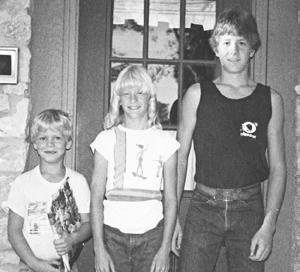

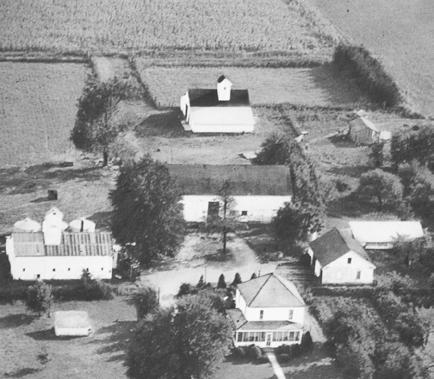
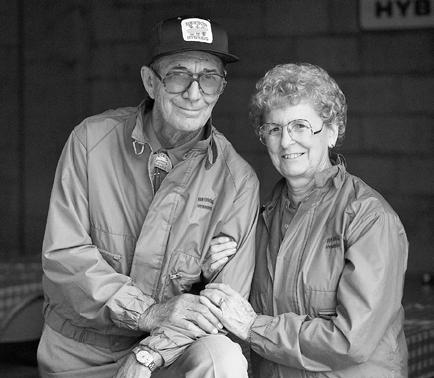
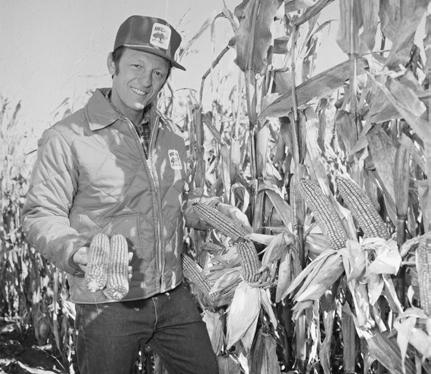
A legacy of faith. A tradition of farming. A future rooted in both.
By Drew Lyon
When a trade delegation arrived during harvest 2025 at Glen Groth’s family farm in southeast Minnesota, it was hard to tell who was more excited for the visit – Glen’s three daughters or the team of South Asian buyers who arrived as part of Northern Soy Marketing’s (NSM) annual Crop Tour.
Let’s call it a tie. The anticipation was mutual.
“It seems like it’s always a hit on both ends,” said Groth, the NSM chair and director with the Minnesota Soybean Research & Promotion Council who hosted a similar trade team last harvest during the 2024 Crop Tour. “The girls were so excited, because they had such a good time last year and the buyers did such a good job in speaking to the girls.”
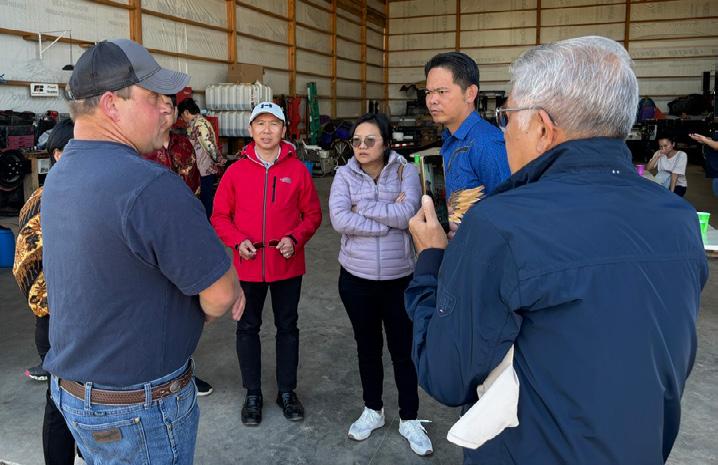
The multi-day, three-state tour arrived at Groth’s farm just a day after he started harvesting his 2025 soybean crop. During the afternoon visit, Groth met with over 15 buyers and producers from Indonesia, Thailand and Vietnam. He provided snacks, including raspberries grown on his farm and Honeycrisp apples developed through the University of Minnesota, explained his growing practices and how his crops are delivered to market, both to domestic and international customers. The Groths also gave a tour of their equipment, including their combine and grain bins, and offered their guests a closer look at Groth’s soybean crop.
“They were really interested in our labor demands and were amazed my wife (Melinda) and I could run our farm with pretty much me and her and some parttime help from my dad,” he said. “With the technology we have, we can accomplish a lot, and they’re not as used to that type of labor efficiency.”
Groth also reconnected with an egg producer from Indonesia, whom Groth met on an NSM trade mission to Southeast Asia.
“It was cool to have that full-circle moment where I saw his farm and he saw mine,” Groth said.
Prior to meeting the Groths, the Southeast Asian delegation, which included poultry farmers and
representatives from feed milling industries, started its tour at the University of Minnesota and met with Soybean Agronomist Seth Naeve, who showcased the composition of Upper Midwest soybeans and highlighted the value of the U.S. Soybean Quality Survey.
Day 2 of the mission began with a stop in Brewster at the Minnesota Soybean Processors facility, which recently celebrated 25 years as a soybean crush and biodiesel facility.
Attendees met with staff and were gifted Minnesota Soybean Processors hats, which the group wore during a visit later that day to the southwest Minnesota farm of Joel Schreurs. While Schreurs’ beans weren’t quite ready for harvest, he gave an overview of the operation and his grain handling equipment, along with explaining how trade is a mutually beneficial relationship.
“We want you to buy our crop, because we want to plant another crop,” Schreurs said during a Q&A session. “That’s what we love to do – I want to farm, and you take our product and turn it into eggs and chicken.”
Schreurs, who has hosted numerous trade teams over the years, said, even with language barriers, he enjoys conversing with his international guests.
“These meetings are very important,” said Schreurs, who also serves as an MSR&PC director and sits on the U.S. Soybean Export Council. “They really make a difference.”
Ann Tang, a Vietnamese soymeal importer, considered her first trip to Upper Midwest a success. She had an up-close look at cutting-edge research, visited a crush facility, saw soybean harvest in action and learned how the beans she imports are shipped via ports at the Pacific Northwest (PNW). She was also pleasantly surprised at the 80-plus degree temperatures.
“My friend said it might be snowing here,” she said.
In the end, the Crop Tour goes beyond agriculture to foster human connections between producers and purchasers, Groth said.
“Sometimes, that goes further than constantly talking about soybeans, and you don’t always get that doing business in other parts of the world,” he said.
The tour continued west to South Dakota with a poultry nutrition research discussion at South Dakota State University, a tour of plant-based feed ingredient producer Houdek, a stop by Jeff Thompson’s farm in Colton, S.D., and at the Central Farmers Cooperative elevator at Lyons, S.D. Farmers from NSM’s member states – Minnesota and South Dakota – produce about 16 percent of the soybeans grown in the U.S. Most of those beans are loaded onto rail and shipped from PNW export facilities. Thus, it was only appropriate that the NSM Crop Tour capped at the PNW, where NSM Executive Director Gary Williams joined participants on a harbor tour of Seattle and AGP’s Terminal 2 at the Port of Grays Harbor.
NSM hopes to continue the trade exchange by embarking on another trade mission to Southeast Asia in early 2026.
“Those are the countries that are the focus of a lot of our efforts in promoting the quality of northerngrown beans,” Groth said.
Northern Soy Marketing is a checkoff collaboration of farmer leaders from MSR&PC and South Dakota Soybean. NSM works across the globe to promote the quality, consistency and reliability of northern-grown soybeans and soymeal by providing a more accurate picture of soybean feeding quality through considering critical essential amino acids rather than crude protein as the true measure of soy quality.
Visit soyquality.com to learn more about NSM’s priorities.

By Drew Lyon
Gail Donkers will never forget the sight of her first soybean crop being raised on her family farm in Wanamingo.
“I remember exactly where they were on the farm and how we had to go out and pull weeds because we couldn’t spray them,” Donkers said. “I thought, ‘What is that?’ My dad always wanted to try something different and find another crop rotation.”
Little did Donkers know that the humble soybean would help her build connections around the world, from meeting the famous Mr. Bean in Singapore – “he just loves Minnesota beans,” she said – to growing checkoff awareness in communities across Minnesota, while learning about the versatility of soy uses, markets and varieties.
“Minnesota Soybean is so diligent and focused on moving the pile and finding new uses to enhance our products,” Donkers said. “It’s been really enlightening to see all the different things we’re involved in.”
In 2025, Donkers became even more involved in promoting the little bean in a big way by becoming chair of the Minnesota Soybean Research & Promotion Council, the organization tasked with directing the state’s soybean checkoff program and overseeing an industry generating nearly $10 billion in revenue to the state’s economy each year. After six years on the Council, Donkers was elected chair in June 2025, replacing Tom Frisch.
“It’s been great working with her. Gail is so knowledgeable, hardworking, driven, outgoing, articulate,” Frisch said. “She has all the characteristics to make a great chair. She’s been a great board member, and she’ll be an even better chair.”
Elected by her director peers, Donkers also made history as the first woman to lead MSR&PC in the more than half-century since the state’s checkoff program was enacted. While Donkers considers herself a farmer
first, she also recognizes the female grower leaders who came before her, who work alongside her and the future farmers bound to follow in her footsteps.
“There have been leaders at both MSR&PC and the Minnesota Soybean Growers Association who paved the way for me to become chair,” said Donkers, who raises soybeans, corn, hogs, dairy steers and sheep. “It’s a legacy I’m proud to be a part of, and I think it’s super important women in ag support each other.”
Donkers, the daughter of a schoolteacher, is passionate about agriculture education and higher learning.
“My mom instilled in us that it’s important that we went to college and had various jobs while farming on the side,” she said. “All of our kids have gone to college as well. I think it’s really good to get away from the farm for a while.”
A former dairy princess, Donkers graduated from the University of Minnesota, where she met her husband, Jim, and has been involved in 4-H and FFA for decades. She’s also a strong supporter of the Council’s investments in the Minnesota Ag in the Classroom program.
“I see the impact that our checkoff dollars have on building the next generation of farmers through supporting education,” Donkers said. “It’s one of my favorite parts of being a director.”
Donkers was first encouraged by her friend Keith Schrader, a former Council chair, in 2011 to run for the District 8 seat. As the bookkeeper on her Rice County farm, Donkers was only vaguely familiar with the soy checkoff. The time wasn’t quite right to run, but she dipped her toes into leadership in 2012 by participating in the Minnesota Agriculture & Rural Leadership Program alongside future colleagues Rochelle Krusemark and Pat Sullivan, two directors she’d
Continued on page 24

On top of her Council role, Donkers is active in numerous agricultural organizations:
• Specialty Soya and Grains Alliance
• Soy Excellence Center Advisory Panel
• Minnesota Soybean Growers Association
• Minnesota FFA Executive Committee
• Minnesota Farmers Union
• Minnesota Farm Bureau
• Minnesota Lamb & Wool Producers
• Continental Dorset Club
• Olde English Babydoll Society
“It’s really encouraging to see the number of young people that these organizations are bringing into the fold,” she said.
rely on when Donkers joined the Council. In 2015, Donkers applied to attend a See For Yourself mission, where she learned how soy checkoff investments in biodiesel build demand.
“We learned a lot about biodiesel and how it works in vehicles and tractors,” Donkers said. “It was a great program to go to as a first timer.”
By 2019, a year after a tornado tore through the family farm, Donkers’ calendar freed up a bit while her kids attended college. The pieces were in place for Donkers to run as Schrader’s successor.
“I knew I wanted to get involved with some area of agriculture on a deeper level,” she said. “The Council seemed like a good fit.”
Donkers’ instincts were correct. She began her first term in July 2019, and despite obstacles posed by the pandemic, her bubbly personality endeared her to colleagues.
“Part of it was finding your people, and I just feel like it’s been such a great program to be involved in,” she said. “I just feel super comfortable at our meetings.”
Before becoming chair, Donkers in 2023 also replaced Schrader on another board, the Specialty Soya and Grains Alliance (SSGA), which promotes identity preserved soybeans in Minnesota and the U.S.

In her role on the Council, Donkers works closely with Minnesota Soybean Growers Association President Darin Johnson to provide support and collaborate on initiatives.
“Being a member of MSGA, I see MSGA is out there fighting for us,” said Donkers, who serves as membership director with Minnesota Farmers Union. “With all the talk about tariffs, the MSGA board has stepped up and is having those conversations.”


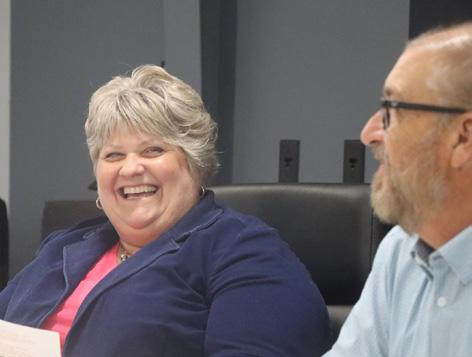
“SSGA has really opened my eyes. I really was not aware of how many food-grade soybeans are grown in Minnesota,” said Donkers, who in September 2024 participated in SSGA’s trade mission to Europe. “It’s hit home for me how important it is for us to be growing these beans and how much they’re appreciated overseas.”
As Donkers worked her way up the officer team – she served two years as vice chair under Frisch – Council CEO Tom Slunecka said Donkers has the ideal character to lead the 15-person board.
“Gail’s demeanor and attitude and commitment to our industry are attributes that fit seamlessly within our mission,” he said. “She’s asking the right questions and focused on the right goals – adding value, building bridges, strengthening markets.”
In her first months overseeing the Council, Donkers has been impressed by the range of projects checkoff dollars are invested in and is determined to collaborate with the officer team to connect with the state’s over 25,000 growers on the longstanding value of the checkoff program.
“We’re making so many investments on new uses and the research side to make farming more efficient. That’s super exciting to me,” she said. “Our officer team is exceptional in bringing forth ways to combat some of the challenges we’ve had. It’s truly been inspirational.”
The single unforgettable soybean crop on the family farm decades ago has led to Donkers as a leading voice in a state that last year planted over 7 million acres of soybeans. She’s ready to lead, eager to learn and support her fellow farmers.
“It’s hard sometimes to see the whole picture, and what I want to keep sharing is that it’s a tough time in agriculture, but we have a lot of really good projects going on right now,” she said. “People are curious about what the checkoff is doing, and I’m excited to share that story.”
Agriculture encompasses most of Donkers’ personal and professional life. But she does enjoy attending concerts with her daughter, Abby (a performance by the Lumineers was a favorite). She also attended the 40th anniversary of Farm Aid in September in Minneapolis, where she ran into her friend and colleague, Tom Frisch.
“That was a pretty epic event,” she said. “My daughter said that was probably the most fun she’s ever had at a concert because we knew so many people.”
By Deanna Kanne
Ever wanted to participate in the collaborative process that determines how checkoff funds are managed? Now’s your big chance to have your say!
The Minnesota Soybean Research & Promotion Council (MSR&PC) has five seats up for election in 2026, spanning almost all districts across the state.
Seats up for election include:
• District 1, 2 & 3 (currently seated by Bill Zurn)
• District 4 (Patrick O’Leary)
• District 5 & 6 (Pat Sullivan)
• District 7 (Ron Obermoller)
• District 8 (Rochelle Krusemark)
“MSR&PC is a very dynamic and diverse council of 15 farmer leaders that oversee the soybean checkoff dollars,” MSR&PC Chair Gail Donkers said. “By investing in new uses, research, promotion and education we work to increase the profitability of soybeans for each and every soybean farmer in Minnesota.”
MSR&PC is seeking diverse perspectives to help direct these checkoff dollar investments into projects that benefit farmers. Directors have a direct impact on how checkoff funds are invested in one of the nation’s leading soybean-producing states, including
sponsoring research, building new markets both domestically and internationally, promoting new uses, communicating checkoff messaging and supporting the next generation of agriculture professionals and leaders.
“We’re always looking for fresh ideas to help direct checkoff investments,” said MSR&PC Vice Chair Ben Storm, who also serves as election chair.
Donkers says one of her priorities as chair is to bring more candidates into the fold.
“The more the merrier,” Donkers said. “A wider pool of candidates benefits all of us as producers and directors.”
Checkoff investments are important to producers no matter the economic climate, but MSR&PC CEO Tom Slunecka said the critical role the checkoff plays in improving profitability is taking on a greater significance.
“This is a great opportunity for farmers to get their voices heard about where they want to see checkoff investments going,” Slunecka said. “In a tough outlook for the farm economy, it’s important to remember the checkoff helps open up new markets and expand new uses
for soybeans. When we pool our resources together, it’s for the betterment of our family farms, our industry and communities.”
Board member benefits include the ability to attend one national United Soybean Board (USB) board meeting per year, the opportunity to develop and enrich strategic business management skills and a chance to assist in the future of Minnesota soybean farmers by directing checkoff dollars. Threeyear terms for each of the five Council seats begin July 1, 2026.
For farmer leaders like Donkers, representing their industry and rural communities brings rewards beyond their own operations.
“I would definitely like to encourage anyone who’s interested to run for the board and learn about what we’re doing and volunteer your time for MSR&PC,” said Donkers, a director since 2019.
“A lot of farmers are curious about what the checkoff is doing and where their dollars are going, and I can tell you from experience that having that firsthand look at how we’re investing those dollars really shows the ways the checkoff is bringing value back to our farms and our communities.”
Interested candidates must be at least 18 years of age and a Minnesota soybean producer
who directly shares in the risk, or loss, from soybean production. Candidates must fill out a candidate certification form and information form, and email completed forms to Melinda Roberts at melinda@ mnsoybean.com, or mail completed forms to the Minnesota Soybean office no later than Jan. 26, 2026. Forms can be found online at mnsoybean.org/msrpc. Ballots will be mailed by the Minnesota Department of Agriculture on March 16, 2026, and all ballots must be postmarked by April 1, 2026. A preview of the candidates will be featured in the March-April 2026 issue of Soybean Business.
“I’m looking forward to learning more about the candidates running and their thoughts on how we can keep our checkoff moving in the right direction,” Donkers said.
Each time a Minnesota soybean farmer brings their soybeans to market, one half of one percent of the market price is contributed to the checkoff. The .5 percent is divided between Minnesota and the United Soybean Board. According to the latest data, the soy checkoff returns $12.30 for every $1 producers invest into the program. In total, checkofffunded initiatives at the national and state level supported nearly 31,000 jobs, added $2.6 billion in labor income, contributed $5.9 billion in total value, and increased the U.S. GDP by $9.8 billion.
1 2 3 4 7 8 9 5 6
MSR&PC Direc tors as of July 1, 2025
Corey Hanson
Bill Zurn
Paul Freeman
Patrick O ’Leary
Tom Frisch
Joe Serbus
Pat Sullivan
George Goblish
Joel Schreurs
Ron Obermoller
Cole Trebesch
Rochelle Krusemark
Gail Donker s
Glen Groth
Ben Storm

By Soybean Business Staff
Soy checkoff research projects often begin with a big idea and, hopefully, conclude by bringing back value that’s applicable to a farming operation – leading to new varieties, bigger yields or tools to fight pests and diseases.
Every step of the way, Minnesota farmer leaders stay engaged in the process. Some, like Gary, Minn., farmer Corey Hanson, even invite researchers to use their farms as study cases.
“I’m always excited this time of year to look at the different projects that the researchers come up with, and people that want to do research from us, their ideas and the new objectives that these researchers want,” said Hanson, a director with the Minnesota Soybean Research & Promotion Council. “It’s an exciting time for those who are passionate about research.”
The Council is now accepting research project proposals for fiscal year 2026. The purpose of this Request for Proposal (RFP) is to solicit pre-proposals from various investigators and collaborators to help enhance environmental stewardship and increase the production profitability of Minnesota soybean producers. To submit a proposal for checkofffunding consideration, email the cover sheet, full project proposal and budget template to projects@ mnsoybean.com by 5 p.m. on Dec. 8, 2025.
The Council is seeking projects in the following areas:
• Soybean pest management
• Agronomic research and technology transfer
• Soybean breeding, molecular genetics and functional genomics
“I’m hoping that we can get some great collaboration between states so we can see the results better and have more data to look at,” Hanson said. “This is a great time to take a fresh look at what we’re funding and what we should be funding to make our checkoff dollars go even further.”
Tasked with wisely directing Minnesota soybean checkoff investments, MSR&PC invests in three core areas: research, education and promotion. The RFP process is a critical component to ensure that checkoff investments represent and address the myriad difficulties and opportunities for Minnesota soybean growers.
“Minnesota is a large and diverse state, offering unique opportunities and challenges in agriculture across its regions,” said Sergio Cabello Leiva, MSR&PC director of research. “The Minnesota Soybean Research & Promotion Council is excited to invest in innovative, science-based projects that help drive progress and strengthen our vibrant soybean industry. We look forward to hearing your ideas!”
Successful research proposals will increase profitability to Minnesota soybean farmers, while promoting, educating and increasing awareness of the state’s nearly 26,000 soybean farmers and the importance of soybeans and soybean products to industry, influencers and consumers.
For more information on the RFP process, visit mnsoybean.org/msrpc. The projects will be reviewed this winter, with the Council approving funding at its April 2026 board meeting.



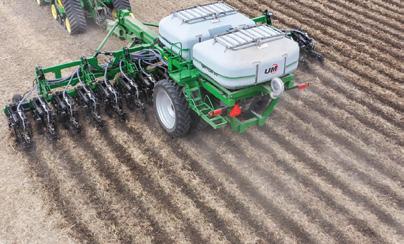
The Raptor® strip-tillage tool models 2130 and 2115 feature the all-new TerrainPro™2 floating row unit that creates ideal seedbed conditions and ensures consistent fertilizer depth across the entire machine. The Raptor is an all-in-one strip-till and fertilizer delivery solution and features a robust design and narrow transport width. Pull-type models are available in 12- or 16-row configurations and can be equipped with a 12-ton dry or 1,200-gallon liquid fertilizer system. 3-point mounted models are available in 6-, 8- or 12-row configurations, and a new pull-type dry fertilizer cart is available for 6- and 8-row models.
The Raptor implement was designed from the ground up to meet the demanding needs of the largest strip-tillage operations.
LEARN MORE ABOUT THE RAPTOR STRIP-TILL TOOL.
› Visit UMequip.com or see your nearest dealer today.

At Asgrow ® brand, not only are we all about the beans, we’re all about your success as well. That’s why we o er localized products with leading genetics, weed management systems and maximum pro t potential – all developed by soybean experts who put soybeans rst.
DISCOVER HOW IT’S ALL ABOUT THE BEANS. Asgrow.com
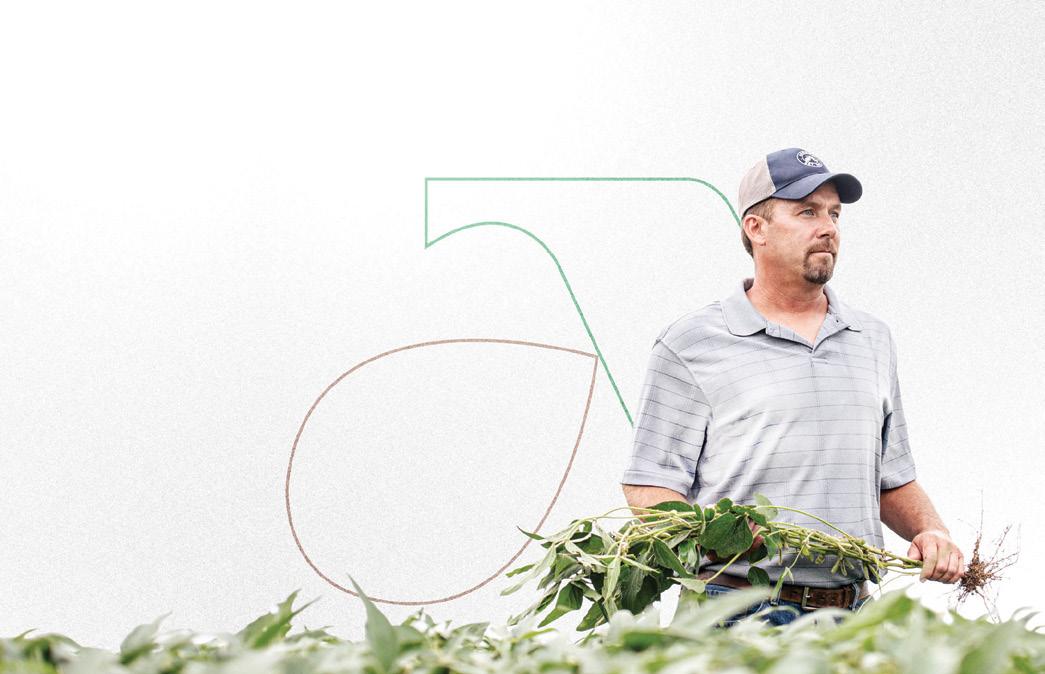


By Bailey Grubish and Drew Lyon
When it comes to occupational dangers, farmers and firefighters can relate. The hazards are always lurking; in farming and firefighting, prevention is paramount.
For firefighters, cancer is the leading cause of death. This exposure stems from the use of foam-based firefighting products that contain PFAS, aka “forever chemicals.”
For farmers and firefighters alike, SoyFoam, a checkoff-supported firefighting foam made with soy flour, has proven dual benefits, says Dave Garlie of Cross Plains Solutions.
“You put the SoyFoam in front of farmers and they see it. They can touch it. It has circularity. It’s got a community effect,” Garlie said. “And it addresses a national crisis. Farmers, and firefighters, love that.”
Throughout 2025, soybean county boards across Minnesota donated hundreds of pails of safer, PFAS-free SoyFoam to their local fire departments, thanks to the Minnesota Soybean Research & Promotion Council (MSR&PC), using soy checkoff funds.
“The improvements coming out are all based on firefighter safety, which is huge,” said Matthew
Grave, deputy fire chief of the Willmar Fire Department. “We’re out there, putting our lives on the line to help people. We always say we’re firefighters, we’re there for everybody on their worst day trying to help them.”
Garlie commended the Council’s foresight in accessing SoyFoam’s potential as a value-added use and a method of building community bonds. By accessing Minnesota’s one-of-a-kind county program, SoyFoam attained a level of media exposure that Garlie said was beyond Cross Plains Solutions’ reach.
“We’re a small company. When we get the farmers’ support, not only through their research checkoff dollars, but the support of Minnesota Soybean to help with this level of promotion across the state, it is so appreciated,” said Garlie, a Minnesota native. “And we’ve been fortunate for the opportunity to utilize very tight, limited dollars for the mission of absolutely finding alternative markets for our farmers and beans. We need a market to get the market moving and we need Minnesota Soybean’s level of expertise, their reach in your communities.”
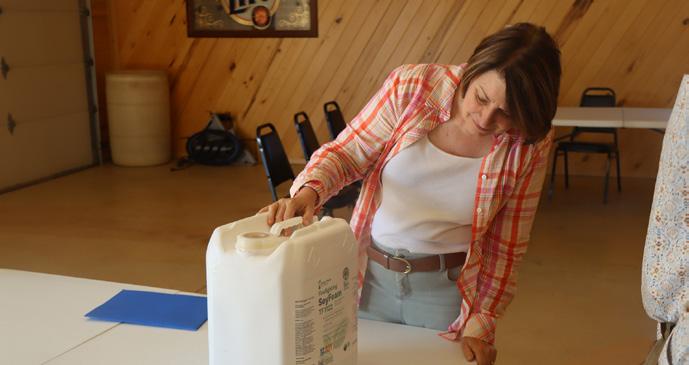

SoyFoam is the key
SoyFoam is made with soy flour and is the first and only Greenscreen Certified Gold fire foam with zero intentionally added PFAS. Firefighters have a nearly 10% higher chance of a cancer diagnosis; SoyFoam is 100 percent biodegradable and 84 percent biobased-made using U.S.grown soy.
“Soybean checkoff dollars went into the development and testing of this product, so it’s funded by the American farmer and uses soybeans grown by the American farmer,” said MSR&PC Treasurer Glen Groth, who farms near Winona. “It’s a win-win for rural America.”
The United Soybean Board began investing checkoff dollars in SoyFoam in October 2022. A year later, the U.S. Forest Service and Department of Defense (DOD) began testing the product. The Council started promoting SoyFoam within Minnesota in 2024, including a demonstration and Soybean Business cover story.
“Our firefighters risk so much for our communities,” MSR&PC Senior
Director of Product Development and Commercialization Mike Youngerberg said. “The soy checkoff is doing its part to find ways to reduce the use and exposure to harmful chemicals, all while creating a demand for our beans. That’s a great story to tell.”
The Council worked with Cross Plains Solutions to educate fire departments about SoyFoam. As of Oct. 1, 2024, firefighting foam containing PFAS was no longer permitted for Class A and Class B fire suppression in Minnesota. SoyFoam was the clear answer.
“SoyFoam is an excellent example of the multiple uses of soy, from feed for livestock to fighting our fires,” said Starbuck farmer Paul Freeman, who also serves on MSR&PC. “We’re grateful for the opportunity to show off this latest innovation and support our local firefighters in the process.”
To show the fire departments and community members how well SoyFoam worked, demonstrations
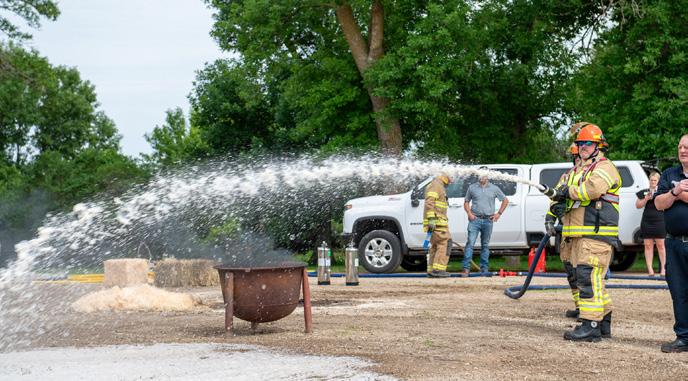
were organized and held by the local county soybean boards throughout 2025.
North of Ada, Minn., fire departments from Norman and Polk counties gathered to participate in a controlled house burn to test SoyFoam in a real situation.
“I was very impressed with how much foam it produced, especially considering we were running at a pretty conservative rate,” Ada Fire Chief Glen Visser said. “It worked very well as a wetting agent around the house, and we also sprayed some on the siding, and where we sprayed was the last part of the house to burn up, so it was impressive to see how well it worked.”
Another training day in northern Minnesota, held near Warroad, had the state fire marshal’s office, ATF, Border Patrol, private companies and more fire departments present. This training was in an abandoned hotel, which provided ample training opportunities to replicate exercises and change variables in similar environments.
In June, Farmamerica, the agricultural interpretive center in Waseca County, hosted a Soy & Tech Day to promote soy-based products, including SoyFoam. The Waseca Fire Department, with help from Cross Plains Solutions, created two demonstrations for SoyFoam at the event.
“I appreciate everything Minnesota Soybean is doing to enhance and find new uses like SoyFoam,” Council Chair Gail Donkers said. “SoyFoam is a product that has checked all the boxes for us.”
In July, with Minnesota Soybean Growers Association Vice President
Continued on page 32
Ryan Mackenthun in attendance, the McLeod County Corn & Soybean Growers held an Ag Safety Day at the county fairgrounds, where they coordinated with the local fire departments to give a demonstration of SoyFoam.
The Renville County Corn & Soybean Growers held a SoyFoam demonstration during their county fair at the demolition derby in August. The demonstration was led by Garlie to show the product in action.
“The firefighters seemed to get a lot out of the demonstration and were surprised at how well the product stuck around after it was used,” Renville County Corn & Soybean Board Chair Nathan Serbus said. “It meant a lot to help facilitate the awareness of a different product that doesn’t have a forever chemical in it.”
There are 44 organized county soybean boards around the state, and since spring 2025, almost all of them participated in the Council’s “Planting to Protect: From Farm to Flame” statewide promotion. In

Lincoln County, growers donated pails to five county fire departments.
“I think it is a great way to not only use soybeans for another use, but it’s a product that doesn’t have the harmful chemicals in it, compared to what they were using in the past,” said Lincoln County Corn & Soybean Board Member Joel Schreurs, a Tyler farmer and MSR&PC director. “I also believe that if we can develop a product that
is safer for our communities and local fire department personnel, it’s beneficial to everyone.”
Tom Frisch, who chaired MSR&PC when the Planting to Protect campaign launched, envisions soy-based products continuing to positively impact farmers’ profitability.
“SoyFoam is a great example of finding ways to use our soybeans and move the pile, while also being environmentally friendly,” said Frisch,

gallons of SoyFoam donated
SoyFoam pails

a volunteer firefighter who also sits on the United Soybean Board. “On top of adding value through checkoff investments, the safety aspect of SoyFoam is so important.”
The solution is soy
While Minnesota Soybean will continue spotlighting SoyFoam, Garlie also has high hopes for the product in 2026. Working with soy and national checkoff partners,
Cross Plains Solutions is looking beyond municipal civilian fire departments after receiving grant funding from DOD. In December 2025, Garlie is presenting to federal officials in Washington, D.C., to advance SoyFoam as a PFAS replacement within the U.S. government.
“As you move up the food chain to the federal level –Department of Defense, U.S.
Forestry Service – there’s a whole different certification (process),” Garlie said. “We have what they considered the safest product option for AFFF PFAS. (Veterans) are in crisis mode – there are like 10,000 vets a week signing up for the PACT Act. It’s all the exposure to PFAS, and SoyFoam, we’re the only one focused on using agricultural feedstock to address the problem.”
There’s already precedence to DOD using soy-based firefighting foam for national security purposes during World War II until the 1960s.
Garlie, and the nation’s halfmillion soybean farmers, hope the past repeats itself.
“It’s a beautiful piece of history,” Garlie said. “That technology was credited with saving thousands of sailors’ lives. That was the gold standard for DOD fire suppression – was soy. So, we’re revisiting history and that’s the message we’re going to bring forward. We’re driving soy as the solution for the major markets.”

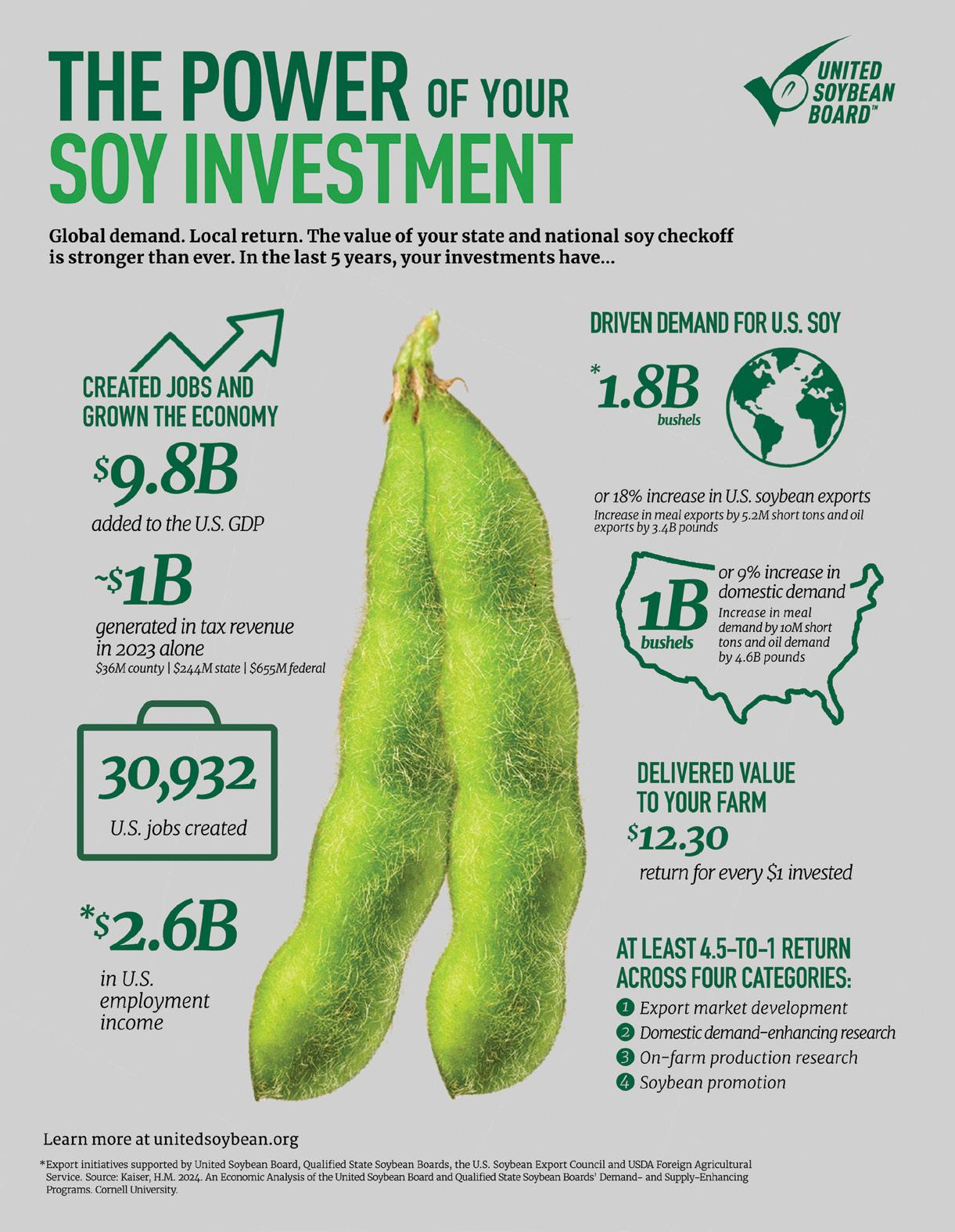







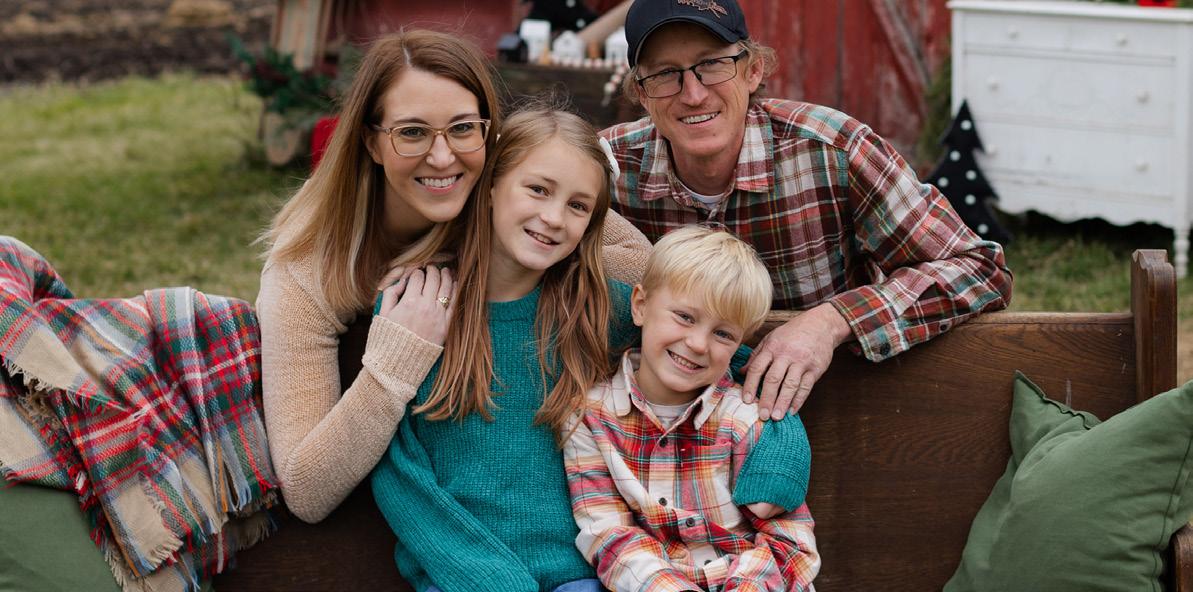
By Deanna Kanne
Ag Management Solutions, the group that oversees Soybean Business, is expanding its communications team and gaining fresh perspectives this fall as 2025 gives way to 2026.
It’s a new day at Minnesota Soybean, says Tom Slunecka, CEO of AMS and the Minnesota Soybean Research & Promotion Council.
“We’re excited to hit the ground running with our new team members,” Slunecka said. “It’s fantastic to grow our team and tap into their various fields of expertise to deliver on behalf of our clients. We can’t wait to showcase their talents with the readers of the Minnesota Soybean Growers Association’s awardwinning magazine, Soybean Business.”
To help fill out the communications department, AMS has added Grace Britton and Allison Wright as communications specialists. Based in southern Minnesota, Britton and Wright will focus mainly on Minnesota Soybean as field representatives in Minnesota’s one-of-a-kind county soybean program, which covers more than 40 counties across the state.
Many of the counties throughout the state have organized corn & soybean growers boards, and communications specialists are used to disseminate state messaging and provide communications support. County organizations are also a good mechanism of leadership development to help the state organization find leaders.
Britton is a southern Minnesota native, growing up on a small livestock and row crop operation near Janesville, where she raises her own herd of Simmental cows while working alongside her dad on the family farm. Britton earned her bachelor’s in animal science from South Dakota State University, with minors in ag
business and agribusiness marketing.
Wright also attended South Dakota State University, majoring in agricultural communications and animal science. She grew up on her family’s farm in Hutchinson, where they raise dairy cows alongside corn and soybeans. The dairy industry has shaped a lot of Allison’s life, as she was a Princess Kay finalist in 2022 and is the dairy royalty coordinator & social media manager for the McLeod County American Dairy Association.
Britton and Wright will be splitting up the southern counties in the state. They will attend numerous county meetings and are there to ensure individual farmer voices are heard by the board.
Sara Hewitt rounds out the team as the new marketing manager. Hewitt returns to AMS from Ten Acre Marketing, where she was an accounts supervisor. She previously worked with AMS for almost six years as manager of industry relations and brand development, where she directed events such as MN Ag Expo. She also contributed as a writer and sales manager for Soybean Business.
“I am excited to be back working for Ag Management Solutions, where the clients and farmers are making a true impact in agriculture,” Hewitt said. “It has very much felt like coming home for me, and I am looking forward to the opportunity to contribute in a new capacity at AMS.”
MSGA Executive Director Joe Smentek said Hewitt’s experience of marketing techniques, policy acumen and extensive farming background will benefit the farmer-led organization.
“Sara is so passionate about agriculture; it’s infectious,” Smentek said. “We’re excited to have her help us on our mission to fight for our farmers during a challenging time in our industry.”
The 2025 harvest has wrapped for most of Minnesota’s farming community. Now is the time for producers to turn their attention to tax planning. As 2025 winds down, Profinium Bank recommends growers meet with their accountants as soon as possible to allow enough time for important year-end planning decisions and consider changes in tax laws or deductions following the passage of the One Big Beautiful Act (OBBA).
“A post-harvest financial update allows a farmer the opportunity to analyze the farm’s financial position and performance to the plan made earlier in the year,” says David Thamert, Profinium Bank’s Senior Vice President Ag Banking/Business. “Having this information helps in making decisions for the upcoming year, including crop rotation, prepaid expenses, marketing decisions, cash flow decisions, capital purchases and sales, and a variety of other decisions.
James Heilman, CPA at Clifton Larson Allen reviews how the legislation impacts producers for 2025 and beyond in multiple ways:
BONUS DEPRECIATION is now permanent for farm assets placed in service after Jan. 19, 2025. This includes barns, tiling, shops and storage sheds.
ESTATE TAX EXEMPTION increased to $15 million per person in 2026 but remains $13.99 million in 2025.
SECTION 179 DEDUCTION: For tax years beginning after Dec. 31, 2024, the deduction increased to $2.5 million with phaseouts increasing to $4-$6.5 million on qualifying purchases.
REVERSAL OF SECTION 174 RESEARCH EXPENSES: Prior to the OBBA, farmers conducting research were required to amortize those costs across five years. Now, growers can fully deduct qualified domestic research expenses in the year they’re incurred and potentially claim R&D Tax Credits.
Heilman also recommends one simple but often overlooked taxsaving opportunity for farmers is contributing toward retirement accounts. Although the farm may serve as the main source of income and wealth, investing in retirement plans – IRAs, SEP IRAs or Solo 401(k)s – can offer valuable tax benefits and longterm financial security. Contributions to these accounts are usually tax-deductible, which helps lower taxable income for the current year; the investments also grow tax-deferred. This

strategic approach not only reduces immediate tax liability but also builds your savings off the farm, providing a safety net during market fluctuations, poor weather seasons or ownership transitions. For farmers with variable earnings, retirement accounts offer both flexibility and the ability to invest in their future while strengthening their overall tax strategy.
Farmers can also alleviate the stress that comes with tax time by making their fourth-quarter safe harbor tax payment by Jan. 15, 2026. This will position producers to avoid the usual March 1 deadline and instead allow them to file by April 15.
For those producers who might only consider their taxes, Profinium offers a few tips for better preparation heading into 2026:
•To ensure you don’t miss deductions, compile a monthly tax folder – digital or physical – to keep receipts, invoices, mileage logs and record notes about big purchases or other major events.
•Embrace technology by using accounting software.
“ There are financial tools that allow you to manage your finances and tax planning throughout the year, and not on a seasonal basis,” Thamert says.
Trust the experts and don’t be afraid to embrace new approaches that minimize tax-induced stress,” Thamert says. You’re likely to be pleased with the results.
“Be open to alternative ways to approach tax season. Your accountant and banker likely see many situations similar to yours and may have good suggestions if you are open to them,” he says.
“Also, marketing advisors often say the market conditions, such as basis and carry, will encourage you to make certain decisions, so being open to those suggestions can lead to better decisions.”
Turn to your hometown experts at Profinum Bank, where “Your Amazing is Possible,” by visiting profinium.com/personal/checking.

Mike Young’s first steps toward improving his soil health began two decades ago with no clear road map or end goal.
“It didn’t start as a ‘soil health journey,’” Young told an assembled group of farmers and industry leaders in September 2025 at his Waverly farm. “For me it started as, ‘There’s got to be a better way.’”
There were no smartphones or easy access for Young to find his way toward adopting strip-till on his soybean and corn operation. Instead, he combed through magazines and talked with his crop adviser, who set out a plan and promptly told Young he was better off selling his land, rather than strip-tilling. Young declined the recommendation and instead sought out matching-funds grants to purchase equipment through his local Soil and Water Conservation District representative, who also responded to Young’s idea to purchase strip-till equipment with skepticism before promising to do further research.
“Sure enough, he called me back three weeks later and said, ‘Hey that strip-tilling thing, they’re doing it in other places! We’ll match that funding,” Young said. “That’s what allowed me to purchase this equipment, was a 50 percent matching grant.”
Young welcomed stakeholders at his farm alongside the Minnesota Department of Agriculture and Minnesota Pollution Control Agency to promote the state’s $200 million to cut climate pollution from food systems through the Climate Smart Food Systems Initiative. The Minnesota Agricultural Water Quality Certification Program

(MAWQCP) received $10 million of the funding via its Soil Health Financial Assistance Program grants and developing markets for continuous living cover crops and cropping systems.
“This is particularly exciting to offer this grant opportunity and work with retailers to buy down the cost of things like nitrogen that farmers buy,” said Brad Redlin, MAWQCP program manager. “Farmers have to take on that expense and, obviously, it’s challenging, especially in these times. We’re happy to lean right into it.”
Young has proven to be a farmer ahead of his time, employing practices before MAWQCP launched. While adopting strip-tilling tested his patience, from costly labor and machinery to time invested, Young said he’s learned valuable lessons along the way. Today, he’s evolved from strip-tilling every spring and fall to every two years, saving equipment costs in the long run.
“We’ve seen great benefits,” he said.
MAWQCP connects farmers with local conservation district experts to identify and mitigate any risks their farm poses to water quality on a field-by-field basis. Producers going through the certification process retain priority access to financial assistance. After being certified, each farm is considered in compliance with new water quality laws and regulations for 10 years.
Since MAWQCP’s statewide launch,1.22 million acres have enrolled in the first-of-its-kind program. The 1,600-plus certified farms have added over 7,872 new conservation practices that protect Minnesota’s waters. These new practices are keeping 68,800 tons of sediment out of Minnesota rivers while saving over 89,800 pounds of phosphorous on farms each year. The conservation practices have also reduced nitrogen loss by up to 45%.

“For me, the return on investment has been unbelievable,” said Young, who enrolled in MAWQCP about six years ago.
Farmers and landowners interested in becoming water quality certified can contact their local Soil and Water Conservation District or visit MyLandMyLegacy.com to enroll and learn more about financial assistance programs.
MDA Commissioner Thom Petersen, who visited with colleagues from across the country while Minnesota hosted the 2025 Farm Aid, said MAWQCP continues to be a model program nationwide.
“We had people from all over the country come here and look at our grant program and MAWQCP, and they all said, ‘We’d love to do something like that in our state,’” Petersen said.







October in Milwaukee.
“These awards celebrate the very best of agricultural marketing,” said NAMA CEO Jennifer Pickett. “Erin embod(ies) the innovation, professionalism and passion that define our industry. (Her) contributions have not only strengthened their organizations but also advanced the mission of NAMA and the broader agrimarketing community.”
Since joining AMS in 2023, Rossow, who farms in Morristown with her husband, Matt, has excelled in creating partnerships, securing sponsorships and delivering growth for multiple agricultural associations, including the Minnesota Soybean Growers Association and Soybean Business. During her tenure, she spearheaded new events that expanded sales and existing trade shows and member initiatives. Known for her creative approach, strong relationship-building, passion for agriculture and steady leadership, Rossow is committed to growing AMS, which is owned by MSGA and the Minnesota Soybean Research & Promotion Council.
To learn more about ad opportunities within Soybean Business and AMS, contact Rossow at erossow@agmgmtsolutions.com.


Professional speaker Steve Fredlund will take the main stage at MN Ag Expo Jan. 21, 2026, in Mankato during lunch to share how doing the “unright” thing in his mind led him to fulfillment through his Safari Way Roadmap speech.
He did the “right” thing attending college and working for a Fortune 500 company, spending most of his career as an actuary before leaving for the “unright” path and finding his passion as a speaker.
“We’re excited to welcome Steve Fredlund to MN Ag Expo,” MSGA President Darin Johnson said.
“His message will resonate with our audience, and he has a compelling story to share his point.”
As a two-time TEDx presenter and author of “Do the Unright Thing,” Fredlund will share his experiences of leading a trip to Rwanda that brought him insight to inspire others that extraordinary results don’t come from ordinary choices.
This is Fredlund’s first visit to MN Ag Expo, though he spoke last year to farmers during a meeting among state soybean groups.
“I’m excited to network and hang out with people, to hear their stories,” Fredlund said. “It’s fun for people to share their stories, but for me, it’s fun to learn more about that. Hopefully I can be at some of the breakouts and chat with some of the people. … For me, that’s helpful to help then spread the message that you guys are delivering internally into my sphere of influence.”
507.344.8888 criminal + injury attorneys

Visit mnagexpo.com for more information on the agenda for MN Ag Expo 2026.
Red crown rot of soybean found in Minnesota for first time Red crown rot (RCR) has been confirmed for the first time in southwestern Minnesota, according to Dr. Dean Malvick, plant pathologist at the University of Minnesota. This marks a significant discovery for Minnesota soybean growers, showing that this southern disease can now be found in our region as well.
RCR is caused by a soilborne fungus that infects soybean roots and lower stems. In southern U.S. states, severe outbreaks have caused yield losses of 40-80%. Early detection and awareness are key to keeping it from spreading.
The disease tends to appear first in low-lying areas or fields with drainage problems and can expand from there as the soil stays saturated. Red crown rot can be tricky to identify early in the season, but its symptoms tend to be more prevalent in July and early August. On leaves, it often looks like Sudden Death Syndrome, showing yellowing and browning between the veins.
Extension specialists, farmers and industry partners are now working together to understand how red crown rot behaves under Minnesota conditions. The focus is on monitoring, containment and developing management practices that protect yield and soil health. Continued scouting and awareness will be the best tools for growers to manage this new challenge in 2026. For further questions, contact Minnesota Soybean Director of Research Sergio Cabello Leiva at scabelloleiva@agmgmtsolutions.com.

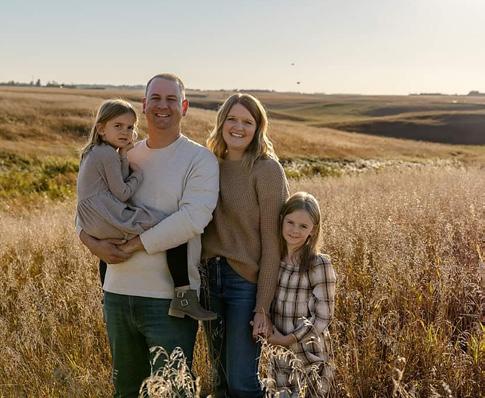
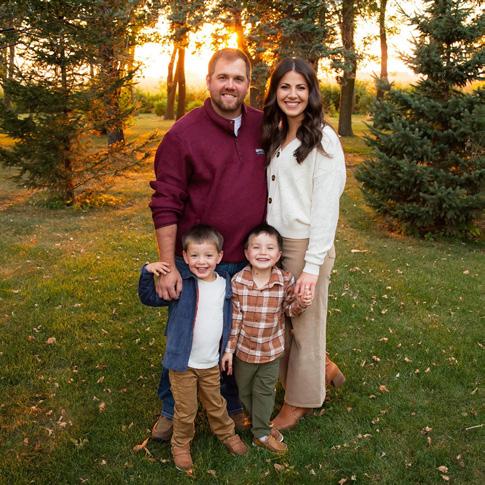
Allen Blankers might be a newcomer to the Minnesota Soybean Growers Association, having joined MSGA during Farmfest this past August, but he’s a veteran farmer. He grew up on a farm north of Lake Wilson and has been actively farming near Holland, Minn., for the past 15 years, raising soybeans and corn with his dad.
Like many farmers, Blankers is involved with multiple organizations. Off the farm, he has a fulltime job as a market president at MinnWest Bank in Marshall, and is actively involved in his community of Woodstock, recognizing that the farm economy is intertwined with his community’s economic health.
“We are going to build a new community center,” Blankers said. “It’s pretty exciting, considering the population of Woodstock isn’t even 150 people.”
As a longtime farmer and banker, Blankers knows that building new markets, both internationally and here at home, is more critical than ever. By joining MSGA, he’s lending his voice to a group that’s advocating for trade and value-added uses.
“With everything going on with the tariff wars, we need more markets to replace the 20 percent we were sending to China annually. We need a voice, essentially, to help break the barriers down.” Blankers said. “The new products are always a huge benefit – that’s the thing that’s got me excited.”
One of the newest members of MSGA, Dusty Compart joined in October 2025 after the Nicollet-Sibley Corn and Soybean Growers delivered a care package consisting of harvest snacks and a promotional mailer showcasing MSGA & MSR&PC priorities.
“I always feel that we get our value from checkoffs, whether it’s pork or corn or soybean checkoffs,” Compart said. “(Joining MSGA is) a small thing to do to support a big organization.”
Compart said he’s interested to see his return value on checkoff investments, including research, promotion and other outreach. On the flip side, he joined MSGA because he recognizes that checkoff dollars can’t be used for governmental advocacy. However, MSGA and the Council share a similar mission: developing new markets and improving existing markets.
“I always like to see what new demand areas they’re working on,” he said. “How is the organization being innovative on how they can use more of our soybeans for different products domestically and be a good demand source for soybeans we produce?”
Compart farms north of Nicollet on a multigenerational farm. Besides soybeans, he grows corn and raises hogs. He and his wife Natalie are raising the next generation on the farm, their two sons.“It’s fun to have them be part of the farm and show interest in it,” he said.
The Minnesota Soybean Growers Association (MSGA) salutes the 10 members who joined MSGA during harvest 2025. We also extend our appreciation to the nearly 80 producers, industry professionals and supporters who renewed their membership from August through October.
With a new legislative session beginning in February, and plenty of critical federal issues that have yet to be resolved, our policy work in 2026 is more important than ever. MSGA advocates and lobbying
Michael Askelson
Brielle Bakken
Blaine Bakken
Brennan Bakken
Bryant Bakken
Betsy Bartness
Anthony Berscheit
Dusty Compart
Kevin Griffin
Levi Lilleberg
team continue pounding the pavement in St. Paul and Washington, D.C., to promote our priorities, with one united objective in mind: protecting the profitability of Minnesota soybean farmers.
To support your industry by becoming a member of the nation’s premier state soybean association, visit mnsoybean.org/msga/invest. Membership levels start at just $20 for students, and a 3-year membership costs just 22 cents per day. Joining MSGA brings a value that just makes sense.
Name:____________________________________Date of Birth:______/________/_______
3 Year Membership: $250 $250 (includes Minnesota Soybean jacket and $100 biodiesel rebate) Pullover size (circle one): S M L
(Value $100)
1 Year Membership: $120 Yes I want to save $20! 1 Year Membership: $100 (with auto renew payment via credit card). By checking this option, I understand my annual membership to MSGA will renew automatically, charging the credit card on file at the time my membership expires Young Professional (age 35 and under) & Retired: $70 Student (age 22 and under): $20
